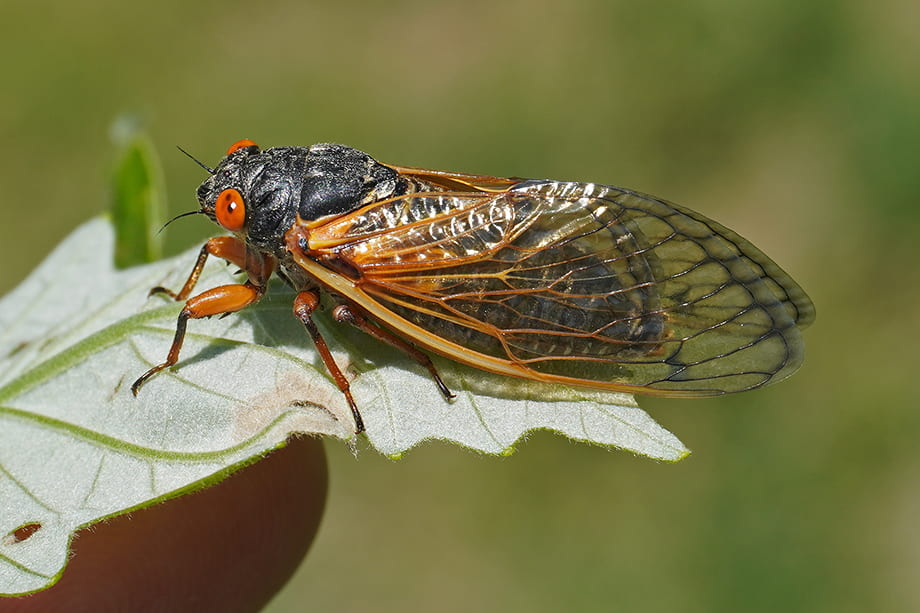
A periodical cicada (Magicicada cassinii) from Brood X rests on a leaf on Friday, May 21, 2021. Credit: Courtesy of Joe Boggs
Columbus may soon fill with the sights and sounds of chirping, red-eyed cicadas, emerging for the first time in 17 years.
Brood X cicadas — one of the largest populations of periodical cicadas geographically — will appear in multiple areas throughout the United States this summer, with larger numbers in Western Ohio, Indiana and Eastern Illinois. The mass emergence is expected to begin once soil temperature reaches 64 degrees Fahrenheit, David Shetlar, professor emeritus of urban landscape entomology in the Department of Entomology at Ohio State, said.
Last appearing in 2004, Brood X surfaces every 17 years and contains three different species, Joe Boggs, assistant professor with Ohio State Extension, Hamilton County, said. This group of periodical cicadas can measure close to an inch in length and differ in appearance from the summer “dog-day” cicadas, which are greener in color.
“Periodical cicadas have red eyes,” Boggs said. “Their bodies are mostly black, and their wings are kind of orangish-red.”
Boggs said the emergence of Brood X cicadas may be slow initially but will pick up rapidly with the most activity in June. Their arrival will also occur in tiers, with each of the three species experiencing a peak and a decline in its emergence cycle.
“The males attract the females by a very specific song, a very specific chorus, specific to that species,” said Boggs. “So you could imagine if all three species were out at once and the males of all three species were singing at the same time.”
As nymphs — or young cicadas — periodical cicadas feed on plant roots and are buried more than half a foot into the soil, Shetlar said. Once the nymphs have fully matured, they will construct an emergence burrow up to the surface of the soil.
The nymphs will then return back down into the soil and feed on plant roots for a while longer before they surface, Shetlar said. Once the nymphs surface, they will climb up a vertical surface, such as a plant, blade of grass or nearby tree.
The nymphs then undergo the molting process — usually overnight — and begin shedding their old exoskeletons for about two to three hours, Shetlar said. When nymphs first emerge from their exoskeletons, they are whiter in color.
“Sometimes I’ve taken kids out to see this and they get pretty bored pretty quickly,” Shetlar said. “It just doesn’t happen real fast.”
The periodical cicadas appear in large numbers to overwhelm predators and increase the chances of successful mating, Boggs said. The massive quantity helps ensure that predators will not be able to eat enough cicadas to critically deplete the population.
“You know, things can eat these things until they’re just stuffed,” Boggs said. “I mean, you see raccoons along the road going, ‘Oh, I can’t eat another one.’”
In addition to serving as a protein banquet for animals such as bears and raccoons, cicadas are natural tree pruners, Boggs said.
After female cicadas lay eggs in the twigs of a tree, he said the twig will likely die as result. Where the original twig breaks off, buds grow and produce two to three new twigs.
“There’s actually some scientific reports that have pointed out that the year following a periodical cicada emergence, most of the trees that received the egg-laying are actually thicker and bushier than they were before,” Shetlar said.
Even in death, cicadas affect trees. Adult cicadas live for four to six weeks, and when they die, they will decompose underneath the trees, Shetlar said.
Despite bolstering tree growth, cicadas may reduce social interaction by interfering with outdoor events held this year, Shetlar said. During the previous Brood X cicada emergence in 2004, their chirping caused a significant disruption to golfers at the Memorial Tournament in Dublin, Ohio.
“It was funny watching the Memorial Tournament on TV, and you know how judges raise their hands for the crowd to be quiet, and cicadas didn’t pay any attention to them,” Shetlar said.
Boggs said the Brood X cicadas could also be on the guest list for summer weddings this year.
“They will be with us in June – I mean, June is going to be a big month for them,” Boggs said. “You know, June weddings can be interesting.”


